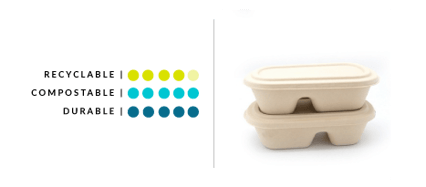From food wrappers, to Amazon boxes, to drink bottles, to toothpaste tubes, most of us don't realize the extent to which product packaging is built into our everyday lives. Product packaging requires a significant amount of raw materials, and now more than ever, we need to prioritize using efficient and sustainable packaging materials. In this post, we take a deep dive into the packaging industry to determine the eco-friendliness of common packaging materials and what major brands are doing to minimize their environmental impact. Continue reading to learn more!
The Problems with Product Packaging
The most common types of packaging materials include plastic, glass, metal, cardboard, paperboard, and Styrofoam. Generally speaking, packaging materials are used to protect the product, extend the shelf-life, and convey important information to the consumer. However, many companies overlook the environmental impact of the packaging materials they use. Mark Dancy, CEO of WasteZero says that companies focus on two priorities when it comes to packaging: “how will this drive consumers to my product and how much does this cost.” More often than not, brands use single-use plastics, Styrofoam, and non-recyclable materials to package their products due to their light weight, durable and inexpensive properties. Unfortunately, however, product packaging like this, by nature, gets discarded after one use and ends up being sent to landfills or incinerators.
According to the EPA, the United States generates almost 80 million tons of packaging waste each year. The leading culprit in this growing problem? Plastic. More than 9.1 billion tons of plastic has been produced since the 1950s, but only 9% of it has been recycled. Given that plastic does not decompose, an estimated 79% accumulates in our natural environments and landfills. In fact, plastic packaging makes up over one-sixth of the waste at landfills in the US.
Over the past decade, online shopping, or e-commerce, has been the root cause of the increase in packaging waste. Fast Company reported that 165 billion packages are shipped in the US each year, which equates to over 1 billion trees worth of cardboard boxes. It goes without saying that the world loves shopping online, but it's important to think about the need for extra packaging materials (shipping boxes) that wouldn't be necessary if we purchased products at a 'brick and mortar' stores whenever possible. Further, e-commerce businesses also need to ensure their products arrive at the customer's doorstep in perfect condition, which often leads to them using extra layers of packaging with protective cushions like packing peanuts or air cushions.
Fortunately, major brands around the world are starting to take action against packaging waste. For example, many businesses are adopting a circular economy model and designing products and packaging for durability, reuse/repair, and recycling. Let's walk through some examples of what businesses are doing to reduce packaging waste and minimize their environmental footprint.
Our Ranking of Packaging in terms of Eco-Friendliness
Bamboo
bamboo has become an attractive alternative to wasteful packaging materials because of its fast growth, durability, and positive impact on the environment. Bamboo packaging is a relatively new concept, but global brands have started taking advantage of its packaging benefits. Dell explains, "Like steel, bamboo can withstand lots of stress while being stretched or pulled, which is why it’s used for boats, construction scaffolding and other items that require strength and flexibility. Because it’s so tough, we know it can protect your technology equipment effectively." Their bamboo packaging is certified as compostable and accepted for recycling. Since it's a new packaging solution, always check with your recycling service provider to see if they accept bamboo packaging.
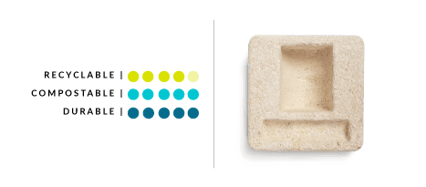
Mushroom
Similarly to bamboo, mushrooms are being used as an environmentally friendly solution for protective packaging. Ecovative Design developed Mushroom Packaging by using agricultural waste and Mycelium (the vegetative root structure of a mushroom) to create a packaging solution comparable to Styrofoam. Ecovative grows its mushroom materials in only nine days, and after use, the company states that the Mushroom Packaging is 100% home compostable. Ikea plans to replace Styrofoam packaging with Mushroom Packaging to reduce waste. Whereas Styrofoam never decomposes, Mushroom Packaging can decompose in just a couple of weeks. Always check with your service provider to see if mushroom packaging is accepted in your community.
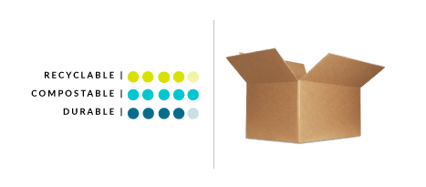
cardboard
Cardboard is a sustainable packaging solution and great for shipping products long-distances. When it comes to disposing of cardboard, either recycling or composting is a great option. Cardboard can be recycled between 5-7 times before the fibers become too short to recycle. Of course, companies still need to be mindful of reducing unnecessary packaging materials. Luckily, Amazon, the world’s most popular online retailer, has set out to reduce excess packaging with "Frustration-Free Packaging." It's made from 100% recyclable materials, efficiently-sized to fit the product inside the box, easy to open, and designed to protect the products inside. As of December 2017, Amazon has reportedly eliminated 215,000 tons of packaging material waste, which is equivalent to 360 million shipping boxes. Amazon is encouraging its vendors to adopt their Frustration-Free Packaging program to help reduce packaging waste.
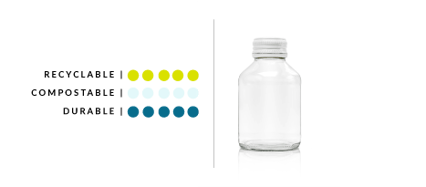
Glass
Glass packaging is starting to make a comeback! Many retailers are beginning to use glass packaging because it's an environmentally-friendly alternative to plastic. Unlike plastic, glass is 100% recyclable and can be recycled indefinitely without any loss of quality or purity. A glass bottle can also go through the recycling process and back on a store shelf in as little as 30 days. LOLI Beauty is a zero waste beauty brand that sells its products in reusable glass containers. Although glass is heavier than other types of packaging, it is an attractive and more sustainable alternative to plastic packaging materials.
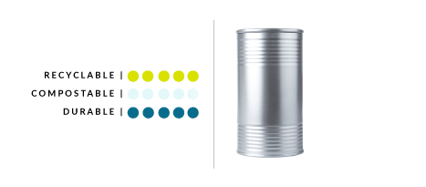
metals (steel, tin, aluminum)
Metal is not a viable option for all products, but it is a preferred packaging material for many industries, especially the food industry. Metal packaging is very durable and a great option when it comes to protecting and storing food and beverages. Similarly to glass, metal packaging is 100% recyclable without any loss of quality. The Aluminum Association estimates that almost 50% of the cans made of the lightweight metal in the U.S. are recycled, compared with about 29% for plastic bottles. In 2019, Coca-Cola announced its plan to start packaging Dasani products in aluminum cans rather than plastic bottles. We're excited to see Dasani's new aluminum packages in the future!
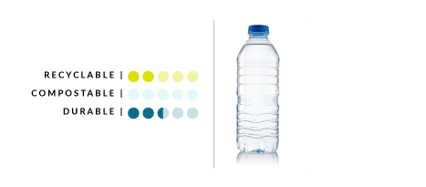
Plastic
Due to the fact that so little plastic is recycled, we are reaching a point as a society where many businesses are searching for ways to phase out plastic materials. Lush eliminates the need for packaging by selling their products ‘naked,’ as they like to call it. Items like shampoos, shower gels, and bath bombs are solid, so they don't require packaging and can be displayed on their own! When packaging is necessary, they use recycled, reused, or recyclable/compostable packaging. Lush states they save millions of plastic packages from being produced each year.
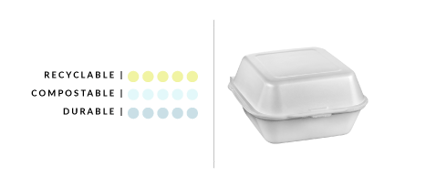
Styrofoam
Polystyrene, the type of product Styrofoam is produced from, is 95% air, making it especially difficult to recycle. It's not biodegradable, rarely recycled, but fortunately easily replaceable. Polystyrene makes up about 35% of waste in U.S. landfill. Dunkin’ has committed to completely phasing Styrofoam cups out of their operations by April 2020. By doing so, Dunkin’ estimates it will help to remove nearly one billion foam cups from the waste stream annually.
We'd love to hear what your business is doing to rethink your packaging strategy. Let us know in the comments section below. If you have any questions, or want to learn how RoadRunner can help your business recycle more, get in touch with us today. Thank you, as always, for reading!

